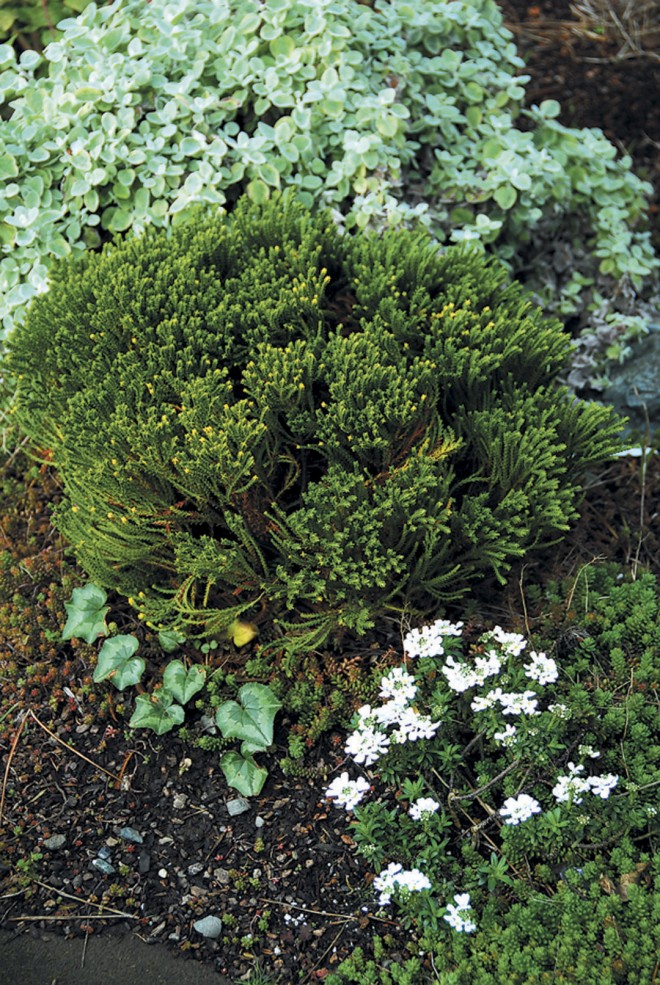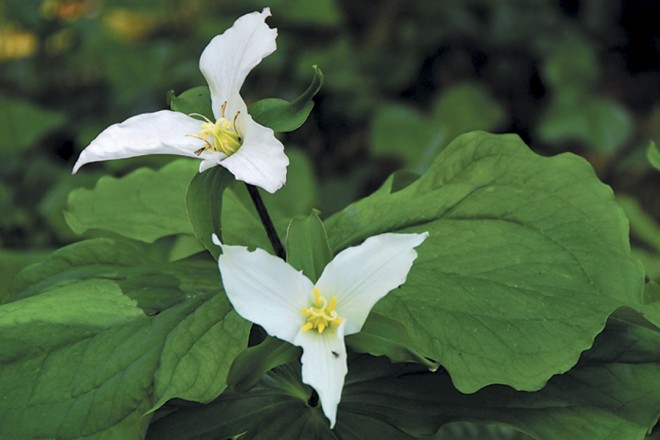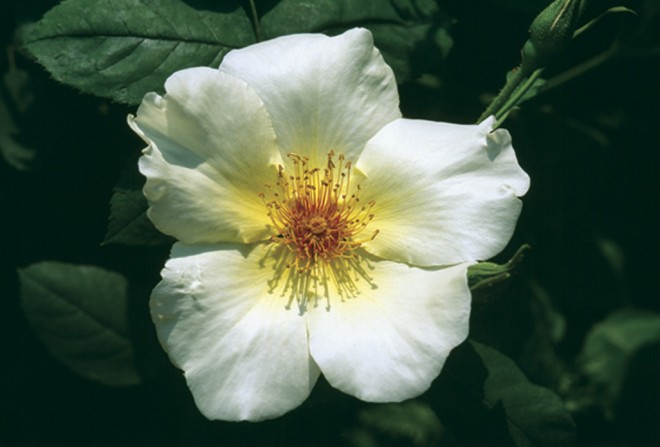
The White Garden

Contributor

[sidebar]I cannot help hoping that the great ghostly barn owl will sweep silently across a pale garden next summer, in the twilight, the pale garden that I am now planting under the first flakes of snow. It is magical.
Vita Sackville-West[/sidebar]
One could not help but be inspired by Vita Sackville-West’s White Garden at Sissinghurst—said to be more imitated than any other garden in the world. Enclosed by a tall hedge, this garden room is subdivided by low hedges defining beds filled with grey and silver leaves and white flowers billowing onto the paths.
First imagined in 1932, the second World War intervened, and it was not until 1960 that Vita’s garden was fully realized. Articles about the new garden appeared regularly in The Observer, and thousands of people followed its development. It was sometimes referred to as the gray garden, or the gray and silver garden. Vita wanted to call it the garth garden (an ancient word for a small enclosure), but somehow it came to be known as the White Garden. It was established at breathtaking speed—conceived, planted, and flowering within five years. It helped that the setting was already there: the box hedges, the yew walk, and the almond trees. In the ensuing decades, the garden has seen many changes, including the replacement of the almonds with bowers of white roses (Rosa mulliganii) that smell faintly of bananas.
A slender statue of a vestal virgin watches over the southern part of the garden. The fragile branches of a weeping pear (Pyrus salicifolia ‘Pendula’) originally surrounded her, but the tree was destroyed in the great storm of October 1987; a new pear is growing up beside her now.
How slender, simple, shy, divinely chaste,
She wilting stood,
Her suppleness at pause, by leisure graced,
In robes archaic by the chisel woo’d,
That smoothly flowed around her waist
And all her figure traced,
And at her feet in fluid ripples broke
Vita Sackville-West, Collected Poems
She looks out on beds edged with grayish green santolina and airy white gypsophylla, which set off a multitude of stately regale lilies (Lilium regale)—a favorite of Sir Harold Nicolson, Vita’s husband. It is interesting to note that her husband contributed the disciplined beds with their boxwood borders, while she furnished the romantic surge of flowers.
It is impossible to describe the beauty of this garden, but Richard Church, who lived in the Priest’s House at Sissinghurst, told of the view from his window:
As I sit here for the first time, in my isolated fragment of the castle, looking out on the main tower across ancient brickwork and an enclosure of hedge-bound flower beds . . . dominant among them is a bed of gigantic [white] delphiniums just to the left of my window. I came to see them by moonlight last summer and they glowed like a collection of cathedrals waiting to be disposed around a Christian community yet to be born.

A Northwest White Garden
I had hopes of creating a white garden here in the Northwest near the ocean, but it is not easy in this climate. I found that white flowers, particularly the delicate ones, either turn limp and bedraggled in the rainy season or become tinged with brown from the summer sun. I compromised by developing a yellow and white bed. After all, I reasoned, Vita allowed some pale pink clumps in her white garden, to strengthen the “whiteness” of the other plantings. I also used sturdy white flowers to highlight other parts of the garden.
The focal point in my yellow and white garden is the shrub rose ‘Golden Wings’. Allowed to spread more or less at will, it has an airy, languid feel to it. The large, single flowers of pale yellow are delicately fragrant and linger on until the end of November. Around her feet are clumps of white false heather (Cuphea hyssopifolia), which will eventually get to be one or two feet tall. In front of the rose is a spreading breath-of-heaven (Coleonema album). Its filmy, yellowish green foliage, rather like heather, is fragrant when brushed against or bruised. Tiny white flowers are scattered over the shrub through much of the year but most generously in late winter and early spring.
Bordering this bed is a low-growing sunrose (Helianthemum), with evergreen leaves that are glossy on top and fuzzy gray beneath. The flowers are like golden celandine; each one lasts only a day, but new buds continue to open over a long season. Flanking the bed on one end is the rose ‘Little White Pet’, which, despite its name, has petals splashed with pale pink. At the other end is a new azalea from New Zealand called ‘September Snow’. Unlike other white azaleas I’ve tried, the flowers remain snowy white and sprightly despite the rain, and they are fragrant to those with a better sense of smell than mine. In the background are two flowering maples (Abutilon) with rich yellow, cup-shaped flowers forever shyly looking down. They are so demure, but I get impatient with them for refusing to look up and show off their charms.
Towering in the rear of the bed are usually a few mullein (Verbascum) that reseed from year to year. They serve well in the background, with big, furry gray green leaves and yellow flowers running up their tall stems. Scattered around are yarrow (Achillea), their flat white and yellow flower heads like small plates, reliably reseeding in a random fashion. Threading through these various plantings is licorice plant (Helichrysum petiolare) with grayish white leaves on woolly trailing stems. The smell of licorice is noticeable on hot still days or when the leaves are dry.
Though a far cry from Vita’s garden, I think my little garden has a charm of its own. Hers was the inspiration. I remind myself that I have neither the staff, nor the climate nor, I reluctantly admit, the artistic genius.

As for white in the rest of my garden, Clematis montana ‘Grandiflora’ is the brightest star. It bursts forth along a fifty-foot section of wooden fence in May, smothering it in a mass of shining white blossoms with golden centers. Perhaps my favorite is the tobacco plant (Nicotiana alata); at dusk, I look down from the deck on its ghostly presence in a distant flower bed. It stands five feet above the other plants and to walk by it is to be enveloped by a heavy fragrance from the white flowers, which only open towards evening or on cloudy days.
A fragrant white rhododendron (Rhododendron maddenii subsp. crassum) has been a disappointment. Planted near the front door, it should scent our comings and goings, yet I can detect no fragrance from it. Visitors claim they do, but I suspect they are just being reassuring. Added to this shortcoming is a tendency for the large flowers to falter before the wind and rain, looking ragged and unkempt. The clumps of Shasta daisy (Leucanthemum X superbum), however, with their shaggy white flowers, maintain a sturdy demeanor and bloom into December.
Walking around my garden in the evening, with my black poodle by my side, I marvel at the luminous quality of the white flowers that seem to shine in the dark. Apart from providing a perfect background for other flowers, they are havens for the eye to rest upon in a colorful garden. Several clumps of white phlox (Phlox paniculata) rise above the surrounding plants, competing with the tobacco plant for sweet fragrance. The small, rounded hebe (Hebe glaucophylla) covers itself with tiny white flowers, each with a minute magenta center, from early summer to the end of the year. A patch of Francoa ramosa sends up spires of white every summer, but the clumps get bigger and bigger and cry out to be divided. It seems to be a feature of this climate that plants start off slowly, and then, after a couple of years, forge ahead as though they intended to take over the world.
I have no doubt that a garden is not complete without white-flowering plants. Not only do they have the unique grace of lighting up the garden, especially at dusk, but they rest the eye and enhance the colors of the flowers all around. And, because many have evolved to depend upon night-flying moths for pollination, their flowers entice us with a beguiling fragrance
Share:
Social Media
Garden Futurist Podcast
Most Popular
Videos
Topics
Related Posts

Ground Up Science for Greener Cities with Garden Futurist Dr. Alessandro Ossola
Spring 2023 Listen to the Podcast here. Alessandro Ossola is a scientist who gets very excited about the challenge of climate change allowing for an

Readying Urban Forests for Climate Realities with Garden Futurist Dr. Greg McPherson
Winter 2023 Listen to the Podcast here. “Going from the mow and blow to a more horticulturally knowledgeable approach to maintaining the landscape. And that

Low Maintenance Gardens – Better for Pollinators and People
Autumn 2022 “I come out every day. It’s therapy, my meditation.” Janet’s young garden transformed from overgrown, invasive plants to mostly natives. The dailiness of

Calochortophilia: A Californian’s Love Affair with a Genus
Summer 2022 I can chart the progression of my life by Calochortus. For the last two decades, at least. As a teenage girl growing up











Responses